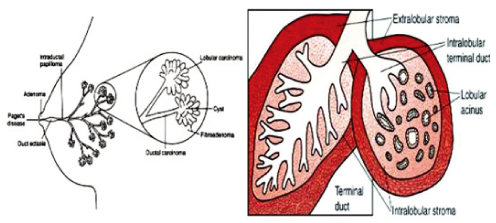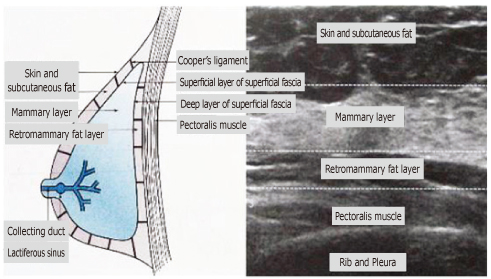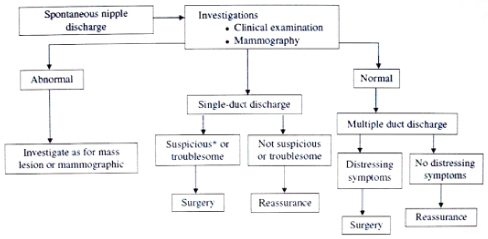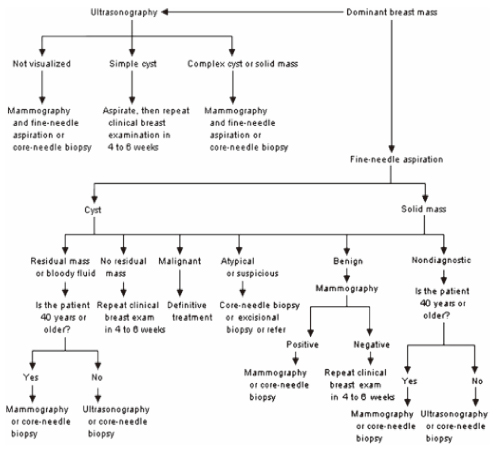Korean J Obstet Gynecol.
2011 Feb;54(2):67-78. 10.5468/KJOG.2011.54.2.67.
The proper approaches for breast disease
- Affiliations
-
- 1Department of Obstetrics and Gynecology, Eulji University College of Medicine, Daejeon, Korea. ithwang@eulji.ac.kr
- KMID: 2037494
- DOI: http://doi.org/10.5468/KJOG.2011.54.2.67
Abstract
- The gynecologists are the primary care physician to women and the breast is an organ of reproduction and reproductive hormones are the most important factors for breast cancer. Therefore it seems logical to accept the position that diseases of the breast are the responsibility of the gynecologists. The breast examination is a part of the through gynecologic examination and the knowledge of the contemporary treatment of breast diseases is an essential components of the current practice of gynecology. In addition to history and physical examination, the gynecologist should be prepared to understand certain diagnostic studies. It seems a logical step that breast cancer patients will be treated by a multidisciplinary team, in which the gynecologist will also take part.
Keyword
MeSH Terms
Figure
Reference
-
1. Venta LA, Dudiak CM, Salomon CG, Flisak ME. Sonographic evaluation of the breast. Radiographics. 1994. 14:29–50.2. Boyd NF, McGuire V, Shannon P, Cousins M, Kriukov V, Mahoney L, et al. Effect of a low-fat high-carbohydrate diet on symptoms of cyclical mastopathy. Lancet. 1988. 2:128–132.3. Fentiman IS, Caleffi M, Brame K, Chaudary MA, Hayward JL. Double-blind controlled trial of tamoxifen therapy for mastalgia. Lancet. 1986. 1:287–288.4. Gateley CA, Mansel RE. Management of cyclical breast pain. Br J Hosp Med. 1990. 43:330–332.5. Conry C. Evaluation of a breast complaint: is it cancer? Am Fam Physician. 1994. 49:445–450. 453–454.6. Chaudary MA, Millis RR, Davies GC, Hayward JL. The diagnostic value of testing for occult blood. Ann Surg. 1982. 196:651–655.7. Pruthi S. Detection and evaluation of a palpable breast mass. Mayo Clin Proc. 2001. 76:641–647.8. Lucas JH, Cone DL. Breast cyst aspiration. Am Fam Physician. 2003. 68:1983–1986.9. Morrow M. The evaluation of common breast problems. Am Fam Physician. 2000. 61:2371–2378. 238510. Is 'fibrocystic disease' of the breast precancerous? Arch Pathol Lab Med. 1986. 110:171–173.11. Berg WA, Gutierrez L, NessAiver MS, Carter WB, Bhargavan M, Lewis RS, et al. Diagnostic accuracy of mammography, clinical examination, US, and MR imaging in preoperative assessment of breast cancer. Radiology. 2004. 233:830–849.12. Berg WA. Rationale for a trial of screening breast ultrasound: American College of Radiology Imaging Network (ACRIN) 6666. AJR Am J Roentgenol. 2003. 180:1225–1228.13. Gordon PB. Ultrasound for breast cancer screening and staging. Radiol Clin North Am. 2002. 40:431–441.14. Gordon PB, Goldenberg SL. Malignant breast masses detected only by ultrasound. A retrospective review. Cancer. 1995. 76:626–630.15. Yoo KY, Kim Y, Park SK, Kang D. Lifestyle, genetic susceptibility and future trends of breast cancer in Korea. Asian Pac J Cancer Prev. 2006. 7:679–682.16. Yoo KY, Kang D, Park SK, Kim SU, Kim SU, Shin A, et al. Epidemiology of breast cancer in Korea: occurrence, high-tisk groups, and prevention. J Korean Med Sci. 2002. 17:1–6.17. Yoo KY, Shin HR, Park SK, Yoon HC, Shin AS, Kang DH, et al. Is breast cancer incidence rate further increasing in Korea? Korean J Epidemiol. 2001. 23:1–7.18. Potten CS, Watson RJ, Williams GT, Tickle S, Roberts SA, Harris M, et al. The effect of age and menstrual cycle upon proliferative activity of the normal human breast. Br J Cancer. 1988. 58:163–170.19. Henderson BE, Ross RK, Judd HL, Krailo MD, Pike MC. Do regular ovulatory cycles increase breast cancer risk? Cancer. 1985. 56:1206–1208.20. Kelsey JL, Bernstein L. Epidemiology and prevention of breast cancer. Annu Rev Public Health. 1996. 17:47–67.21. Hunter DJ, Spiegelman D, Adami HO, van den Brandt PA, Folsom AR, Goldbohm RA, et al. Non-dietary factors as risk factors for breast cancer, and as effect modifiers of the association of fat intake and risk of breast cancer. Cancer Causes Control. 1997. 8:49–56.22. Collaborative Group on Hormonal Factors in Breast Cancer. Breast cancer and hormone replacement therapy: collaborative reanalysis of data from 51 epidemiological studies of 52,705 women with breast cancer and 108,411 women without breast cancer. Lancet. 1997. 350:1047–1059.23. Petridou E, Panagiotopoulou K, Katsouyanni K, Spanos E, Trichopoulos D. Tobacco smoking, pregnancy estrogens, and birth weight. Epidemiology. 1990. 1:247–250.24. de Waard F, Trichopoulos D. A unifying concept of the aetiology of breast cancer. Int J Cancer. 1988. 41:666–669.25. Henderson BE, Ross R, Bernstein L. Estrogens as a cause of human cancer: the Richard and Hinda Rosenthal Foundation award lecture. Cancer Res. 1988. 48:246–253.26. Ota DM, Jones LA, Jackson GL, Jackson PM, Kemp K, Bauman D. Obesity, non-protein-bound estradiol levels, and distribution of estradiol in the sera of breast cancer patients. Cancer. 1986. 57:558–562.27. Koch OR, Pani G, Borrello S, Colavitti R, Cravero A, Farre S, et al. Oxidative stress and antioxidant defenses in ethanol-induced cell injury. Mol Aspects Med. 2004. 25:191–198.28. Son BH, Ahn SH, Lee MH, Park SK, Kim SW. Korean Breast Cancer Society. Hereditary breast cancer in Korea: a review of the literature. J Breast Cancer. 2008. 11:1–9.29. Park SK, Yoo KY, Kang DH, Ahn SH, Noh DY, Choe KJ. The estimation of breast cancer disease-probability by difference of individual susceptibility. Cancer Res Treat. 2003. 35:35–51.30. Kim EK, Kim KS, Park SK, Ahn SH, Lee MH, Kim SW, et al. The Korean Hereditary Breast Cancer (KOHBRA) Study: Protocol Review. J Breast Cancer. 2007. 10:241–247.31. Lee SY, Kim MT, Kim SW, Song MS, Yoon SJ. Effect of lifetime lactation on breast cancer risk: a Korean women's cohort study. Int J Cancer. 2003. 105:390–393.32. Do MH, Lee SS, Jung PJ, Lee MH. Intake of fruits, vegetables, and soy foods in relation to breast cancer risk in Korean women: a case-control study. Nutr Cancer. 2007. 57:20–27.33. Hong SA, Kim K, Nam SJ, Kong G, Kim MK. A case-control study on the dietary intake of mushrooms and breast cancer risk among Korean women. Int J Cancer. 2008. 122:919–923.34. Xue F, Michels KB. Intrauterine factors and risk of breast cancer: a systematic review and meta-analysis of current evidence. Lancet Oncol. 2007. 8:1088–1100.35. Schernhammer ES. In-utero exposures and breast cancer risk: joint effect of estrogens and insulin-like growth factor? Cancer Causes Control. 2002. 13:505–508.36. Michels KB, Xue F. Role of birthweight in the etiology of breast cancer. Int J Cancer. 2006. 119:2007–2025.37. Jung A, Schuppe HC, Schill WB. Are children of older fathers at risk for genetic disorders? Andrologia. 2003. 35:191–199.38. Glaser RL, Jabs EW. Dear old dad. Sci Aging Knowledge Environ. 2004. 2004:re1.39. Ekbom A, Hsieh CC, Lipworth L, Adami HQ, Trichopoulos D. Intrauterine environment and breast cancer risk in women: a population-based study. J Natl Cancer Inst. 1997. 89:71–76.40. Hubinette A, Lichtenstein P, Ekbom A, Cnattingius S. Birth characteristics and breast cancer risk: a study among like-sexed twins. Int J Cancer. 2001. 91:248–251.41. Casey PM, Cerhan JR, Pruthi S. Oral contraceptive use and risk of breast cancer. Mayo Clin Proc. 2008. 83:86–90.42. Brohet RM, Goldgar DE, Easton DF, Antoniou AC, Andrieu N, Chang-Claude J, et al. Oral contraceptives and breast cancer risk in the international BRCA1/2 carrier cohort study: a report from EMBRACE, GENEPSO, GEO-HEBON, and the IBCCS Collaborating Group. J Clin Oncol. 2007. 25:3831–3836.43. Rossouw JE, Anderson GL, Prentice RL, LaCroix AZ, Kooperberg C, Stefanick ML, et al. Risks and benefits of estrogen plus progestin in healthy postmenopausal women: principal results From the Women's Health Initiative randomized controlled trial. JAMA. 2002. 288:321–333.44. Middleton LP, Amin M, Gwyn K, Theriault R, Sahin A. Breast carcinoma in pregnant women: assessment of clinicopathologic and immunohistochemical features. Cancer. 2003. 98:1055–1060.45. Ring AE, Smith IE, Ellis PA. Breast cancer and pregnancy. Ann Oncol. 2005. 16:1855–1860.46. Sharp C, Shrimpton JA, Bury RF. Diagnostic medical exposures: advice on exposure to ionizing radiation during pregnancy. 1998. Oxon (England): National Radiological Protection Board.47. Jernstrom HC, Johannsson OT, Loman N, Borg A, Olsson H. Reproductive factors in hereditary breast cancer. Breast Cancer Res Treat. 1999. 58:295–301.48. Kroman N, Jensen MB, Melbye M, Wohlfahrt J, Mouridsen HT. Should women be advised against pregnancy after breast-cancer treatment? Lancet. 1997. 350:319–322.49. Ives A, Saunders C, Bulsara M, Semmens J. Pregnancy after breast cancer: population based study. BMJ. 2007. 334:194.50. Oktay K, Buyuk E, Libertella N, Akar M, Rosenwaks Z. Fertility preservation in breast cancer patients: a prospective controlled comparison of ovarian stimulation with tamoxifen and letrozole for embryo cryopreservation. J Clin Oncol. 2005. 23:4347–4353.51. Neven P, De Muylder X, Van Belle Y. Tamoxifen-induced endometrial polyp. N Engl J Med. 1997. 336:1389.52. Early Breast Cancer Trialists' Collaborative Group. Polychemotherapy for early breast cancer: an overview of the randomised trials. Lancet. 1998. 352:930–942.53. Howell A, Cuzick J, Baum M, Buzdar A, Dowsett M, Forbes JF, et al. Results of the ATAC (Arimidex, Tamoxifen, Alone or in Combination) trial after completion of 5 years' adjuvant treatment for breast cancer. Lancet. 2005. 365:60–62.54. Jakesz R, Jonat W, Gnant M, Mittlboeck M, Greil R, Tausch C, et al. Switching of postmenopausal women with endocrine-responsive early breast cancer to anastrozole after 2 years' adjuvant tamoxifen: combined results of ABCSG trial 8 and ARNO 95 trial. Lancet. 2005. 366:455–462.55. Coombes RC, Hall E, Gibson LJ, Paridaens R, Jassem J, Delozier T, et al. A randomized trial of exemestane after two to three years of tamoxifen therapy in postmenopausal women with primary breast cancer. N Engl J Med. 2004. 350:1081–1092.56. Goss PE, Ingle JN, Martino S, Robert NJ, Muss HB, Piccart MJ, et al. A randomized trial of letrozole in postmenopausal women after five years of tamoxifen therapy for early-stage breast cancer. N Engl J Med. 2003. 349:1793–1802.57. Baum M, Budzar AU, Cuzick J, Forbes J, Houghton JH, Klijn JG, et al. Anastrozole alone or in combination with tamoxifen versus tamoxifen alone for adjuvant treatment of postmenopausal women with early breast cancer: first results of the ATAC randomised trial. Lancet. 2002. 359:2131–2139.58. Kangas L. Agonistic and antagonistic effects of antiestrogens in different target organs. Acta Oncol. 1992. 31:143–146.59. Garuti G, Cellani F, Centinaio G, Sita G, Nalli G, Luerti M. Baseline endometrial assessment before tamoxifen for breast cancer in asymptomatic menopausal women. Gynecol Oncol. 2005. 98:63–67.60. Vosse M, Renard F, Coibion M, Neven P, Nogaret JM, Hertens D. Endometrial disorders in 406 breast cancer patients on tamoxifen: the case for less intensive monitoring. Eur J Obstet Gynecol Reprod Biol. 2002. 101:58–63.61. Fisher B, Costantino JP, Redmond CK, Fisher ER, Wickerham DL, Cronin WM. Endometrial cancer in tamoxifen-treated breast cancer patients: findings from the National Surgical Adjuvant Breast and Bowel Project (NSABP) B-14. J Natl Cancer Inst. 1994. 86:527–537.62. Lingeman CH. Etiology of cancer of the human ovary: a review. J Natl Cancer Inst. 1974. 53:1603–1618.63. Demopoulos RI, Touger L, Dubin N. Secondary ovarian carcinoma: a clinical and pathological evaluation. Int J Gynecol Pathol. 1987. 6:166–175.64. Moore RG, Chung M, Granai CO, Gajewski W, Steinhoff MM. Incidence of metastasis to the ovaries from nongenital tract primary tumors. Gynecol Oncol. 2004. 93:87–91.65. Hann LE, Lui DM, Shi W, Bach AM, Selland DL, Castiel M. Adnexal masses in women with breast cancer: US findings with clinical and histopathologic correlation. Radiology. 2000. 216:242–247.66. Dixon MJ, Bundred NJ. Harris JR, Lippman ME, Morrow M, Osborne CK, editors. Diagnosis and management of benign breast diseases. Diseases of the breast. 2000. 2nd ed. Philadelphia (PA): Lippincott Williams and Wilkins;48.67. Klein S. Evaluation of palpable breast masses. Am Fam Physician. 2005. 71:1731–1738.68. Beral V. Million Women Study Collaborators. Breast cancer and hormone-replacement therapy in the Million Women Study. Lancet. 2003. 362:419–427.
- Full Text Links
- Actions
-
Cited
- CITED
-
- Close
- Share
- Similar articles
-
- Current Approaches in Development of Immunotherapeutic Vaccines for Breast Cancer
- Genetic Susceptibility of Breast Cancer in Korea: Molecular Epidemiological Approaches
- A general perspective on breast disease and training system for breast cancer specialists in Europe
- Breast Cancer During Pregnancy
- Breast Cancer during Pregnancy





